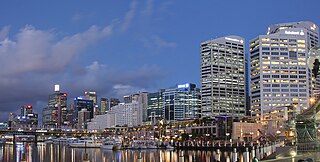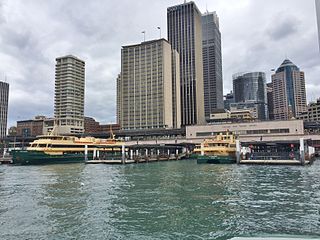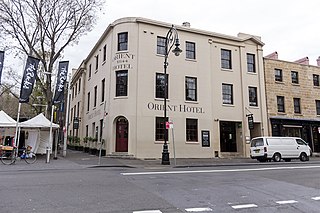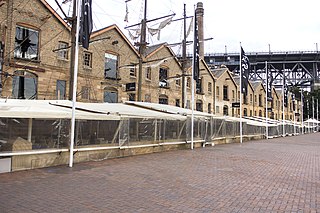
Darling Harbour is a harbour adjacent to the city centre of Sydney, New South Wales, Australia that is made up of a large recreational and pedestrian precinct that is situated on western outskirts of the Sydney central business district.

Circular Quay is a harbour, former working port and now international passenger shipping port, public piazza and tourism precinct, heritage area, and transport node located in Sydney, New South Wales, Australia on the northern edge of the Sydney central business district on Sydney Cove, between Bennelong Point and The Rocks. It is part of the local government area of the City of Sydney.

Circular Quay railway station is a heritage-listed elevated commuter rail station that is located on the City Circle route, serving the Circular Quay precinct of the Sydney central business district in New South Wales, Australia. It is served by Sydney Trains T2 Inner West & Leppington, T3 Bankstown and T8 Airport & South line services.

Museum railway station is a heritage-listed underground commuter rail station that is located on the City Circle route at the southern end of Hyde Park in the Sydney central business district of New South Wales, Australia. The station is served by Sydney Trains T2 Inner West & Leppington and T3 Bankstown T8 Airport & South lines. The station is named after the nearby Australian Museum. It was added to the New South Wales State Heritage Register on 2 April 1999.

The Pyrmont Bridge, a heritage-listed swing bridge across Cockle Bay, is located in Darling Harbour, part of Port Jackson, west of the central business district in the City of Sydney local government area of New South Wales, Australia. Opened in 1902, the bridge initially carried motor vehicle traffic via the Pyrmont Bridge Road between the central business district and Pyrmont. Since 1981 the bridge has carried pedestrian and bicycle traffic only, as motor vehicles were diverted to adjacent freeway overpasses. The bridge was added to the New South Wales State Heritage Register on 28 June 2002.

Circular Quay Ferry Wharf is a complex of wharves at Circular Quay, on Sydney Cove, that serves as the hub for the Sydney Harbour ferry network.

Double Bay ferry services connect wharves in Sydney's Eastern Suburbs with Circular Quay by commuter ferry. The services are provided by Sydney Ferries, an agency of the Government of New South Wales. The route is coloured dark green on the current Sydney Ferries network map. SuperCats are the primary vessel on the route with some Double Bay services operated by First Fleet ferries.

The Manly wharf is a heritage-listed passenger terminal wharf and recreational area located at West Esplanade and serving Manly, a Sydney suburb in the Northern Beaches Council local government area of New South Wales, Australia. It was designed by Arthur Baldwinson and built from 1939 to 1941 by the New South Wales Maritime Services Board. The wharf was added to the New South Wales State Heritage Register on 18 April 2000.

The Darling Harbour ferry service, officially known as F4 Darling Harbour, was a commuter ferry service in Sydney, New South Wales. Part of the Sydney Ferries network, it was operated by the State Transit Authority from its commencement in the 1980s, the Sydney Ferries Corporation from 2004, and Harbour City Ferries from 2013 to its decommissioning in 2017. It serviced the Lavender Bay and Darling Harbour areas. First Fleet and HarbourCat ferries usually operated the service, which was replaced with the F4 Cross Harbour service on 26 November 2017.

The Overseas Passenger Terminal (OPT), known officially as the Sydney Cove Passenger Terminal, is a public passenger terminal servicing cruise ships and ocean liners located in Circular Quay, Sydney, Australia. Whilst commercial shipping operations on and around the site date from 1792, the current primary structure and waterfront promenade date from 1958, with subsequent on-going alterations and land reclamation throughout the latter part of the 20th century. The current design retains the black steel portal frame trusses of the original 1958 structure, with major additions completed in 1988 in the Post-War International Style through the collaboration of Sydney architects Lawrence Nield and Peter Tonkin.

The ASN Co building is a heritage-listed building located at 1-5 Hickson Road, The Rocks, Sydney, New South Wales, Australia. Completed in 1885 and built in the Pre-Federation Anglo Dutch style under the direction of William Wardell and his associate, Walter Liberty Vernon, the building served as the principal offices and warehouse for the Australasian Steam Navigation Company until the company's merger in 1887, when the Government of New South Wales acquired the land used for ordinance facilities and later as government administration offices. Since 1989 the building has been owned by the Sydney Cove Redevelopment Authority and its successors. The building is currently used as an art gallery to display the works of Ken Done.

The Orient Hotel is a heritage-listed pub located at 87-89 George Street, in the inner city Sydney suburb of The Rocks in the City of Sydney local government area of New South Wales, Australia. It was built from 1843 to 1844. The property is owned by Property NSW, an agency of the Government of New South Wales. It was added to the New South Wales State Heritage Register on 10 May 2002.

The Campbell's Stores is a heritage-listed former warehouse building in the inner city Sydney suburb of The Rocks in the City of Sydney local government area of New South Wales, Australia. The Victorian Georgian building previously served as store houses and maritime bonded warehouses. It was built from 1850 to 1861. It faces Campbells Cove, an inlet in the north-west of Sydney Cove. In the 1970s, along with the general decline of commercial shipping activities in Sydney Cove, the building was converted for use as tourist-orientated restaurants and bars.

The Argyle Cut is a heritage-listed roadway and road cutting located at Argyle Street in the inner city Sydney suburb of The Rocks in the City of Sydney local government area of New South Wales, Australia. It was built from 1843 to 1868 with convict and paid labour. The property is owned by the Sydney Harbour Foreshore Authority, an agency of the Government of New South Wales. It was added to the New South Wales State Heritage Register on 10 May 2002.

The Argyle Bridge is a heritage-listed road bridge that carries Cumberland Street across the Argyle Cut and Argyle Street in the inner city Sydney suburb of The Rocks in the City of Sydney local government area of New South Wales, Australia. It was built from 1911 to 1912. It is also known to include the Argyle Stairs. The property is owned by the Property NSW, an agency of the Government of New South Wales. It was added to the New South Wales State Heritage Register on 10 May 2002.

The Metcalfe Bond Stores is a heritage-listed former bond store and warehouse and now shops and offices located at 68-84 George Street in the inner city Sydney suburb of The Rocks in the City of Sydney local government area of New South Wales, Australia. It was built from 1912 to 1916. It is also known as New Metcalfe Bond Stores. The property is owned by Property NSW, an agency of the Government of New South Wales. It was added to the New South Wales State Heritage Register on 10 May 2002.

107–109 George Street, The Rocks is a heritage-listed restaurant and former retail building, residence and bakery located at 107–109 George Street, in the inner city Sydney suburb of The Rocks in the City of Sydney local government area of New South Wales, Australia. It was built during 1860. It is also known as Rockpool Restaurant (former); and William Blue Dining. The property is owned by Property NSW, an agency of the Government of New South Wales. It was added to the New South Wales State Heritage Register on 10 May 2002.

Sydney Cove West Archaeological Precinct is a heritage-listed precinct that contains The Rocks police station, the Museum of Contemporary Art Australia, car park, parks, shops and roads located at 112-156 George Street, in the inner city Sydney suburb of The Rocks in the City of Sydney local government area of New South Wales, Australia. The precinct previously contained a commissariat store, Maritime Services Board offices, dockyard and Department of Labour & Industry offices. Buildings in the precinct were developed in various stages since 1797 to date, with heritage-listed buildings dating from 1797 to 1939. The precinct is also known as the Museum of Contemporary Art, Maritime Services Board, Colonial Government naval dockyard, Commissariat Stores, Colonial Hospital, Kings and Queens Wharf and First Fleet Park. The property is owned by Property NSW, an agency of the Government of New South Wales. It was added to the New South Wales State Heritage Register on 5 August 2011.

Grafton Bond Store is a heritage-listed former bond store and warehouse and now offices located at 60 Hickson Road, in the inner city Sydney suburb of Millers Point in the City of Sydney local government area of New South Wales, Australia. The 1881 sections of the building were designed by William Wardell. It was incorporated into the new Maritime Centre in the 1980s. It was added to the New South Wales State Heritage Register on 18 April 2000.

The Sussex Hotel is a heritage-listed hotel at 20 Sussex Street, Sydney, New South Wales, Australia. It was built from 1913 to 1915. Historically known as the New Hunter River Hotel, it was known as the Big House Hotel from 1973 until 1991, then as Napoleon's Hotel, Moreton's on Sussex and Moreton's Hotel before adopting its current name. It was added to the New South Wales State Heritage Register on 2 April 1999.






















